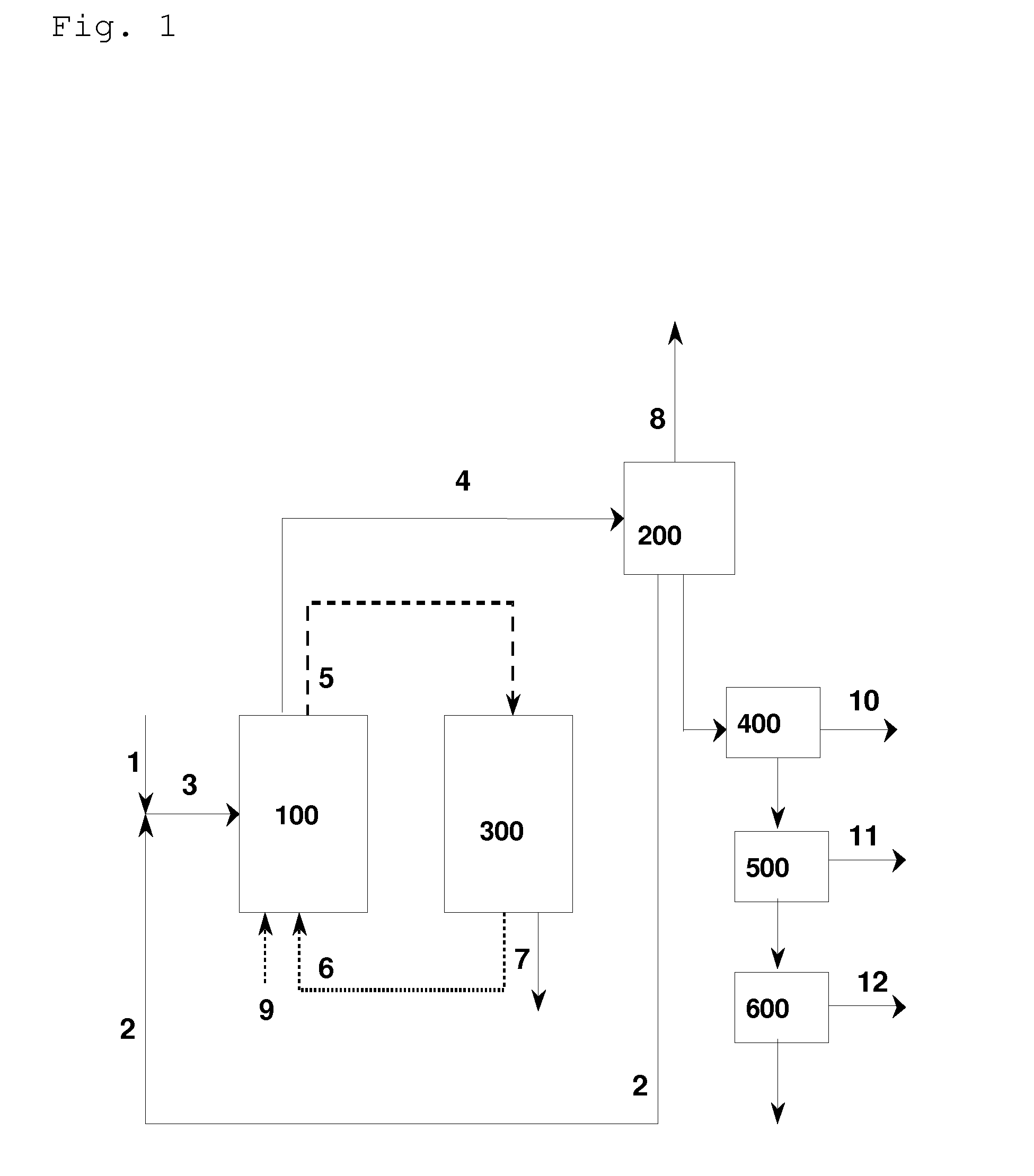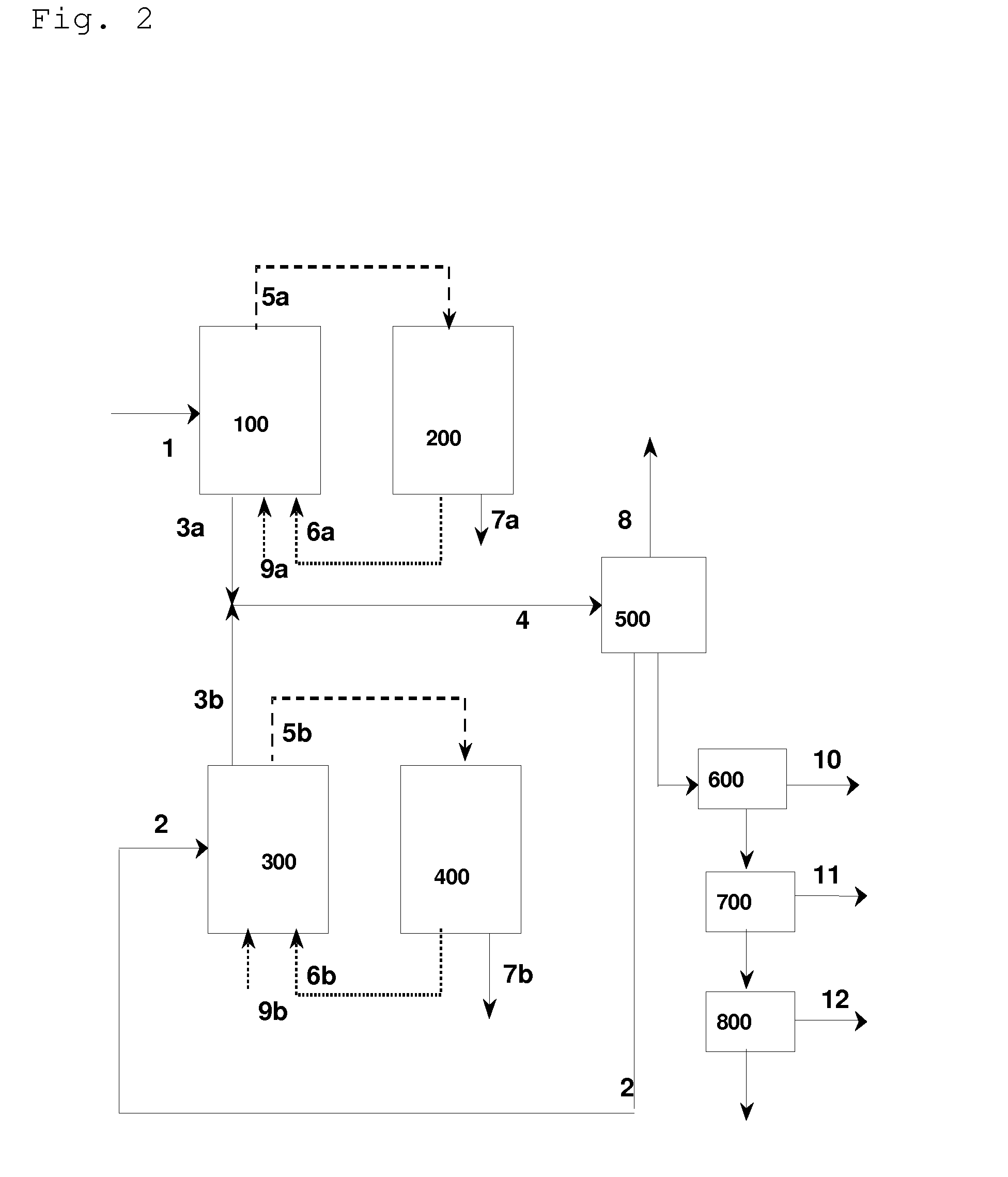Process for the conversion of mixed lower alkanes to aromatic hydrocarbons
a technology of aromatic hydrocarbons and lower alkanes, which is applied in the direction of hydrocarbon preparation catalysts, gaseous fuels, fuels, etc., can solve the problems of high temperature severity, high temperature, and one-stage process operation at high temperature severity, and achieve the effect of reducing the number of benzenes needed, reducing the number of benzenes, and increasing the cost of production
- Summary
- Abstract
- Description
- Claims
- Application Information
AI Technical Summary
Benefits of technology
Problems solved by technology
Method used
Image
Examples
example 1
[0037]In this example the results of laboratory tests are used to represent a one-stage aromatization process vs. a two-stage process utilizing the same catalyst in each stage. The lower alkane feedstock of this example consists of 50 wt % each of ethane and propane, and the temperature of the second stage is higher than the temperature of the first stage.
[0038]Catalyst A was made on 1.6 mm diameter cylindrical extrudate particles containing 80 wt % of zeolite ZSM-5 CBV 2314 powder (23:1 molar SiO2 / Al2O3 ratio, available from Zeolyst International) and 20 wt % alumina binder. The extrudate samples were calcined in air up to 650° C. to remove residual moisture prior to use in catalyst preparation. The target metal loadings for Catalyst A were 0.025% w Pt and 0.09 wt % Ga.
[0039]Metals were deposited on 25-100 gram samples of the above ZSM-5 / alumina extrudate by first combining appropriate amounts of stock aqueous solutions of tetraammine platinum nitrate and gallium(III) nitrate, dilu...
example 2
Process Configuration Comparisons
2.1 One-Stage Process (Comparative)
[0055]FIG. 1 is a schematic flow diagram, which illustrates the process scheme for producing aromatics (benzene and higher aromatics) from a feed containing 50 wt % ethane and 50 wt % propane using a one reactor-regenerator stage process.
[0056]25 tonnes / hr (tph) of stream 1, which constitutes primarily 50 / 50 (ethane / propane) mixed feed (including minor amounts of methane, butane, etc.) is mixed with a recycle stream 2 that consists primarily of ethane and other hydrocarbons, possibly including but not limited to, ethylene, propane, propylene, methane, butane and some hydrogen. The total feed stream 3 is now introduced to the single stage aromatization reactor 100. The aromatization reactor system may be a fluidized bed, moving bed or a cyclic fixed bed design. Here the cyclic fixed bed design is used. The reactor system employs “Catalyst A” described in example 1 above. The unconverted reactants as well as the produ...
example 3
[0064]In this example the results of laboratory tests are used to represent a one-stage aromatization process vs. a two-stage process utilizing the different catalysts in each stage. The lower alkane feedstock of this example consists of 50 wt % each of ethane and propane, and the temperature of the second stage is higher than the temperature of the first stage.
[0065]Catalyst B was prepared on a sample of zeolite ZSM-5 CBV 3024E powder (30:1 molar SiO2 / Al2O3 ratio), available from Zeolyst International. The ZSM-5 powder sample was calcined in air up to 650° C. to remove residual moisture prior to use in catalyst preparation. The target metal loadings for Catalyst B were 0.04 wt % each of platinum and tin.
[0066]Metals were deposited on a 50-gram sample of the above ZSM-5 powder by first combining appropriate amounts of stock aqueous solutions of tetraammine platinum nitrate and tin(IV) tetrachloride pentahydrate, diluting this mixture with deionized water to a volume just sufficient ...
PUM
| Property | Measurement | Unit |
|---|---|---|
| temperature | aaaaa | aaaaa |
| temperature | aaaaa | aaaaa |
| temperature | aaaaa | aaaaa |
Abstract
Description
Claims
Application Information
 Login to View More
Login to View More - R&D
- Intellectual Property
- Life Sciences
- Materials
- Tech Scout
- Unparalleled Data Quality
- Higher Quality Content
- 60% Fewer Hallucinations
Browse by: Latest US Patents, China's latest patents, Technical Efficacy Thesaurus, Application Domain, Technology Topic, Popular Technical Reports.
© 2025 PatSnap. All rights reserved.Legal|Privacy policy|Modern Slavery Act Transparency Statement|Sitemap|About US| Contact US: help@patsnap.com


